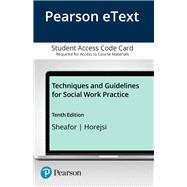Emphasizes the different techniques needed for successful social work practice.
Techniques and Guidelines for Social Work Practice demonstrates the unique place of social work among the helping professions. Readers will gain insight into the social worker's professional roles, guiding principles, and the importance of evidence-based practice. This title provides students with easy access to the most current information on fundamental techniques and useful guidelines for social work practice from the generalist perspective. The 10th Edition introduces 12 new techniques or guidelines corresponding to the national social work licensing examinations and the Council on Social Work Education's list of essential practice behaviors.
For courses in Social Work Practice.
Pearson eText is an easy-to-use digital textbook that you can purchase on your own or instructors can assign for their course. The mobile app lets you keep on learning, no matter where your day takes you, even offline. You can also add highlights, bookmarks, and notes in your Pearson eText to study how you like.
NOTE: This ISBN is for the Pearson eText access card. Pearson eText is a fully digital delivery of Pearson content. Before purchasing, check that you have the correct ISBN. To register for and use Pearson eText, you may also need a course invite link, which your instructor will provide. Follow the instructions provided on the access card to learn more.











